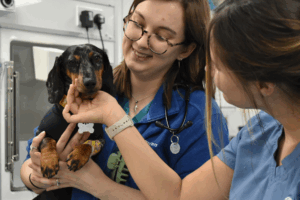Chinchillas originated in the Andes Mountains of South America. They have been trapped to near extinction for their luxurious fur. They are now a popular pet in the UK.
They can live from 8 – 15 years and a normal adult bodyweight is between 450 – 800g, depending on the sex of the chinchilla. They are clean, active, quiet and slightly shy, meaning that they are more appropriate as pets for older children and adults. They are naturally nocturnal but adapt to owner schedules and are active during the day.
Companionship
Chinchillas are not solitary animals, so should be housed in pairs or groups, either single sex or mixed. If you are thinking of having a mixed group of chinchillas and do not want to breed from them, it is best to have them neutered.
Housing
Chinchillas are very active and require a large cage that is long, wide and high, and generally the bigger the better. Mesh cages are best, with the holes no larger than 15mm to prevent foot and limb injury. The cage should also have a tray beneath the wire mesh bottom to collect droppings. Keep newspaper in this tray to absorb any urine that may come through. Provide a wooden nest box, which may need to be replaced frequently due to gnawing – chinchillas love to chew!
Make sure you place wooden shelves for your chinchilla to sit on and chew, soft woods are best for this. Apple and pear tree branches are also good for them to chew on. Chinchillas are very clean animals so like to use dust baths for cleaning themselves in. You can buy special containers to put the dust in, but you could use a large metal pet food bowl. Put the dust bath into their cage for them to use a few times a week, but make sure it is removed after 30 minutes, or they may use it as a toilet!
Chinchillas are fine in normal household temperatures and should not be kept outside. They should be kept as constant as possible, so away from radiators and any draughts. They bear the cold well due to their thick fur coats, but be careful that the room does not exceed 28ºC as they may start to overheat. When they’re hot, they send blood to their ears, so having red ears is a sign that they are too hot.
Handling
Chinchillas can be easy to scare, so you will need to earn their trust before handling them. When you approach them, crouch down and speak very softly. Let them come to you – perhaps hold a treat in your hand for them to have, and be patient. They may not come to you the first time you try this. Then move on to gently stroking them, ensure you use slow hand movements so as not to scare them. Once they are happy for you to have your hands near them, gently place your hand under their bottom, and the other one supporting their back and hold them into your chest with their head facing you. Their ribs are extremely fragile so take extra care to be gentle with them. If you handle them regularly then they will become more confident.
Chinchillas very rarely bite, but they’re sensitive to rough handling and show their distress in other ways. Keep an eye out for ‘fur slip’, when patches of fur are shed, which is a sure sign of fear or distress. Never pick your chinchilla up by the tail – it will cause pain and distress and may lead to fur slip.
Grooming
You don’t need to groom chinchillas – they do it themselves in the sand bath. Your chinchillas won’t like being brushed and it would damage their fur. It’s also important that you never get your chinchillas wet.
Neutering
Chinchillas can be neutered from 5-6 months of age. It is more common for the males to be neutered (castrated), as they can be aggressive towards other males in single sex groups, and to prevent unwanted litters when in mixed groups. The males are neutered more often than females, as they have a less invasive procedure than the females. However, female chinchillas can be neutered (spayed).
Feeding
You should be feeding your chinchilla a mixture of hay, pelleted food, and fresh greens.
Your chinchilla should have constant access to hay and grass foods, as this is important for their dental and gastrointestinal health. This should make up the majority of their diet. You also need to provide them with a commercial diet, providing them with the correct nutrients that they need. Ensure you choose a ‘nugget’ food, rather than muesli-style. With the muesli-style diets, they pick out the parts that they like and leave the parts that they don’t, which means that they may not get all of their required nutrients. Nugget-style pellets prevent this selective feeding, as each pellet has an equal amount of nutrients. Finally, you can also give your chinchillas some fresh greens, but not too many! About a teaspoon is recommended. Please see the list below for details of good greens to feed, and ones that are bad for them, or even poisonous.
Good Food:
Apples, blueberries, carrots, celery, grapes, oranges, cooked potato, pumpkin, squash and cooked sweet potato. A chinchillas favourite treat will always be raisins!
Bad/Poisonous Food:
Asparagus, peas, cabbage, corn, lettuce, broccoli, rhubarb & rhubarb leaves, spinach, foxglove, lily, rose, periwinkle, all nightshades, aloe vera, boxwood, amaryllis, apple leaf, cherry laurel, gaultheria, poppy, tulip, fern, all ivy, tomato plant, hyacinth, primrose, daffodil, autumn crocus, mistletoe, all olives, delphinium, gernanium, holly, chrysanthemum, clematis, forget-me-not, lavender and hydrangea macrophylla.
The above list of bad and poisonous greens is not exhaustive, so always be careful what you feed to your chinchilla.
Chinchillas can be fussy eaters, so take care when changing foods, and always ensure you change foods over gradually over a few days.
Common Health Problems
Dental Problems:
Your chinchilla’s teeth grow continuously for their entire life, so it is important to give them the correct diet to ensure their teeth do not become overgrown. Typical symptoms of overgrown teeth are excessive drooling and loss of appetite
Respiratory Problems:
There are three signs to look out for:
•Wheezing or chest difficulties may be a sign of a chest infection or pneumonia
•A runny nose is linked to the common cold
•Ear discharges or imbalance might mean an ear infection
Chinchillas are also very sensitive to draughts and damp which can lead to colds, so make sure they’re protected.
Constipation:
Signs to look out for: your chinchillas will look bloated and there will be fewer droppings than usual – and the ones you do find will be smaller and thinner. This is usually caused by stress, pain or a lack of fibre and water, so access to plenty of fresh drinking water and lots of hay is important.
Diarrhoea:
This is quite a common problem with chinchillas and is usually a sign of over-eating – especially with treats or vegetables. Other causes might be stress, lack of fibre or a simple reaction to some bad food. Avoid feeding any treats if they have diarrhoea.
Bumblefoot:
This condition, also called ulcerative pododermatitis, can be identified by ulcers on the feet and can be extremely painful if the ulcers get infected. Make regular checks to make sure the soles of their feet aren’t flaky or cracked – if they are, see a vet straight away.
Health Checks
Every chinchilla is different, so it’s good to regularly check your chinchilla, so you know what is normal or abnormal for your pet. It is best to do these checks once a week, it is also a good chance to bond with your chinchilla, and offer them a treat afterwards to show it’s a good thing! If you spot anything out of the ordinary, phone your vet for advice.
Ears:
Gently look inside and make sure they’re clean and free from discharge, which can be a sign of infection. Mites and fleas can also find their way in here
Eyes: Make sure their eyes are clear and shiny, not dull or swollen. There shouldn’t be any excessive blinking or too much wetness around the eyes
Teeth:
Check to make sure there isn’t any excessive drooling which can be a sign of dental problems. Be careful with this health check: your pet might not be comfortable with having their mouth inspected and may bite – in which case, let your Vet do the check instead
Fur:
Gently feel and look to check that there are no bald patches, no signs of mites or fleas and no injuries
Feet:
Gently hold and feel the feet to make sure your pet hasn’t injured themselves. Signs of flaking or cracks mean a visit to the Vet straight away
Weight:
Weigh your pet on a regular basis to see that they are maintaining a constant weight that is healthy for their age. Regular visits to your vet will tell you what their weight should be. Watching the scales is important – obesity is a serious illness that can lead to other health problems





